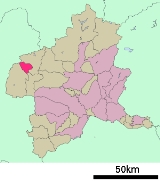
Kusatsu, Gunma
Encyclopedia

Towns of Japan
A town is a local administrative unit in Japan. It is a local public body along with prefecture , city , and village...
in Agatsuma District
Agatsuma District, Gunma
is a district located in Gunma Prefecture, Japan.As of July 1, 2011, the district has an estimated population of 60,253 and a population density of 47.1 persons per km²...
in Gunma Prefecture
Gunma Prefecture
is a prefecture of Japan located in the northwest corner of the Kantō region on Honshu island. Its capital is Maebashi.- History :The remains of a Paleolithic man were found at Iwajuku, Gunma Prefecture, in the early 20th century and there is a public museum there.Japan was without horses until...
, Japan. Kusatsu is situated about 1,200 meters above sea level. The active volcano Kusatsu-Shirane (2,160 m high) and the inactive Mount Tengu
Mount Tengu
is a 2,646m mountain on the border of Chino and Koumi of Nagano in Japan. This mountain is the highest mountains of Northern Yatsugatake Volcanic Group.- Description:...
(1,385 m high) and Mount Motoshirane (2,171 m high) are located west of Kusatsu.
Climate
Due to the altitude Kusatsu's annual average temperature is 7°C, with a maximum temperature of around 30°C during summer and a minimum temperature of -14°C in winter. The main rainy season is from June to September.Population, economy, and infrastructure
Kusatsu has a population of 7,419, which is slowly decreasing. The town's main income is tourism (about 90% of the working population is employed in the tertiary sector), with very little industryIndustry
Industry refers to the production of an economic good or service within an economy.-Industrial sectors:There are four key industrial economic sectors: the primary sector, largely raw material extraction industries such as mining and farming; the secondary sector, involving refining, construction,...
and almost no agriculture
Agriculture
Agriculture is the cultivation of animals, plants, fungi and other life forms for food, fiber, and other products used to sustain life. Agriculture was the key implement in the rise of sedentary human civilization, whereby farming of domesticated species created food surpluses that nurtured the...
. Kusatsu's infrastructure
Infrastructure
Infrastructure is basic physical and organizational structures needed for the operation of a society or enterprise, or the services and facilities necessary for an economy to function...
is well developed: Besides road 292, there are bus connections from Naganohara-Kusatsuguchi station, Shinjuku, Tokyo
Shinjuku, Tokyo
is one of the 23 special wards of Tokyo, Japan. It is a major commercial and administrative center, housing the busiest train station in the world and the Tokyo Metropolitan Government Building, the administration center for the government of Tokyo.As of 2008, the ward has an estimated population...
, and other areas. During the winter season the streets are kept free of snow using onsen
Onsen
An is a term for hot springs in the Japanese language, though the term is often used to describe the bathing facilities and inns around the hot springs. As a volcanically active country, Japan has thousands of onsen scattered along its length and breadth...
water.
Onsen
Kusatsu is one of the most popular hot springs resortsOnsen
An is a term for hot springs in the Japanese language, though the term is often used to describe the bathing facilities and inns around the hot springs. As a volcanically active country, Japan has thousands of onsen scattered along its length and breadth...
in Japan and regularly achieves high rankings in Japan-wide surveys.
There are about 100 onsen in Kusatsu with a total amount of about 34,000 liters water per minute pouring out of the ground. The water is sulfur
Sulfur
Sulfur or sulphur is the chemical element with atomic number 16. In the periodic table it is represented by the symbol S. It is an abundant, multivalent non-metal. Under normal conditions, sulfur atoms form cyclic octatomic molecules with chemical formula S8. Elemental sulfur is a bright yellow...
ous and acid. The hot springs are said to help cure the following ailments: arthralgia
Arthralgia
Arthralgia literally means joint pain; it is a symptom of injury, infection, illnesses or an allergic reaction to medication....
, stiff shoulders, paralysis
Paralysis
Paralysis is loss of muscle function for one or more muscles. Paralysis can be accompanied by a loss of feeling in the affected area if there is sensory damage as well as motor. A study conducted by the Christopher & Dana Reeve Foundation, suggests that about 1 in 50 people have been diagnosed...
, hardenings, bruise
Bruise
A bruise, also called a contusion, is a type of relatively minor hematoma of tissue in which capillaries and sometimes venules are damaged by trauma, allowing blood to seep into the surrounding interstitial tissues. Bruises can involve capillaries at the level of skin, subcutaneous tissue, muscle,...
s, sprain
Sprain
A sprain is an injury in a joint, caused by the ligament being stretched beyond its capacity. A muscular tear caused in the same manner is referred to as a strain. In cases where either ligament or muscle tissue is torn, immobilization and surgical repair may be necessary...
s, chronic indigestion, hemorrhoids, chills, arteriosclerosis
Arteriosclerosis
Arteriosclerosis refers to a stiffening of arteries.Arteriosclerosis is a general term describing any hardening of medium or large arteries It should not be confused with "arteriolosclerosis" or "atherosclerosis".Also known by the name "myoconditis" which is...
, burns, chronic gynecological disorders.
The water from the onsen is used not only for bathing but also for heating of the city's primary and secondary schools, the municipal welfare center, the streets during winter and many households, as well as for the municipal swimming pool.
Sister cities
Kusatsu has numerous sister cities in Japan and around the world. In Japan these are mostly onsen towns or seaside resorts such as:- Hayama, KanagawaHayama, Kanagawais a town located in Miura District, Kanagawa Prefecture, on central Honshū, Japan. As of 2010, the town had an estimated population of 32,386 and a density of 1,900 per km². The total area was 17.06 km²...
- Noboribetsu, HokkaidōNoboribetsu, Hokkaidois a city in Iburi subprefecture, Hokkaidō, Japan. Part of Shikotsu-Toya National Park, it is southwest of Sapporo, west of Tomakomai and northeast of Hakodate. The name, Noboribetsu, derives from an Ainu word, nupur-pet, which means dark-coloured river....
- Gero, GifuGero, Gifuis a city in Gifu Prefecture, Japan. The city is famous for its hot springs. The Hida River runs throughout the city.-History:The city was established on March 1, 2004 by the merger of the towns of Gero, Hagiwara, Kanayama and Osaka, and the village of Maze, all from Mashita...
- Arima OnsenArima Onsenis an onsen, or hot springs in Kita-ku, Kobe, Japan. This Onsen is still a hidden treasure of modern Kobe, behind Mount Rokko. It attracts many Japanese who want tranquility with beautiful natural surroundings and yet easy access from the busy cities in Kansai metropolitan area including...
Another sister city is Kusatsu, Shiga
Kusatsu, Shiga
is a city located in Shiga Prefecture, Japan. The city was founded on October 15, 1954, and as of 2008, the city has an estimated population of 123,690 and the density of 1,820 persons per km². The total area is 67.92 km².- Overview :...
.
Outside Japan, Kusatsu has the following sister cities: Bietigheim-Bissingen
Bietigheim-Bissingen
Bietigheim-Bissingen is the second-largest town in the district of Ludwigsburg, Baden-Württemberg, Germany with 42,515 inhabitants in 2007. It is situated on the river Enz, close to its confluence with the Neckar, about 19 km north of Stuttgart, and 20 km south of Heilbronn.- Buildings...
, Germany
Germany
Germany , officially the Federal Republic of Germany , is a federal parliamentary republic in Europe. The country consists of 16 states while the capital and largest city is Berlin. Germany covers an area of 357,021 km2 and has a largely temperate seasonal climate...
. The town in which Kusatsu's benefactor Erwin Bälz
Erwin Bälz
Erwin Bälz was a German internist, anthropologist, personal physician to the Japanese Imperial Family and cofounder of modern medicine in Japan.- Biography :...
was born. The contacts with this sister town are the most intensive. There is an annual student exchange. Neustift
Neustift im Stubaital
Neustift im Stubaital is a municipality in the district Innsbruck-Land. It has an area of and is the 3rd largest municipality of Tyrol in area. Its population is 4,522. It is a major tourist centre, with more than 1 million overnight stays per year.-Geography:Neustift is located 25 kilometres ...
, Austria
Austria
Austria , officially the Republic of Austria , is a landlocked country of roughly 8.4 million people in Central Europe. It is bordered by the Czech Republic and Germany to the north, Slovakia and Hungary to the east, Slovenia and Italy to the south, and Switzerland and Liechtenstein to the...
. Winter sports resort town. Contact established through the Austrian national ski team. Karlovy Vary
Karlovy Vary
Karlovy Vary is a spa city situated in western Bohemia, Czech Republic, on the confluence of the rivers Ohře and Teplá, approximately west of Prague . It is named after King of Bohemia and Holy Roman Emperor Charles IV, who founded the city in 1370...
(Karlsbad, Carlsbad), Czech Republic
Czech Republic
The Czech Republic is a landlocked country in Central Europe. The country is bordered by Poland to the northeast, Slovakia to the east, Austria to the south, and Germany to the west and northwest....
. Spa resort town, was compared with Kusatsu by Bälz
Erwin Bälz
Erwin Bälz was a German internist, anthropologist, personal physician to the Japanese Imperial Family and cofounder of modern medicine in Japan.- Biography :...
. Snowy River, Australia
Australia
Australia , officially the Commonwealth of Australia, is a country in the Southern Hemisphere comprising the mainland of the Australian continent, the island of Tasmania, and numerous smaller islands in the Indian and Pacific Oceans. It is the world's sixth-largest country by total area...
. This town is located on the same latitude as Kusatsu, only in the southern hemisphere.
Kusatsu is member of the from Komoro, Nagano
Komoro, Nagano
is a city located in Nagano, Japan.As of May 1, 2011, the city has an estimated population of 44,270. The total area is 98.66 km².-Municipal Timeline:*February 1, 1954-Komoro absorbed the villages of Kawanabe, Kitaoi, and Osato from Kitasaku District....
to Nikkō, Tochigi
Nikko, Tochigi
is a city in the mountains of Tochigi Prefecture, Japan. Approximately 140 km north of Tokyo and 35 km west of Utsunomiya, the capital of Tochigi Prefecture, it is a popular destination for Japanese and international tourists...
. This road is a "partner road" to the German romantic road
Romantic Road
The Romantic Road is the term for a theme route coined by travel agents in the 1950s to describe the of highway in southern Germany , between Würzburg and Füssen. In medieval times it used to be a trade route, connecting the center of Germany with the South...
.
Yayoi period
The legendary origin of Kusatsu goes back to the second century during the Yayoi period. According to the legend, either Yamato TakeruYamato Takeru
, originally Prince Ousu was a Japanese legendary prince of the Yamato dynasty, son of Keikō of Yamato, a legendary monarch who is traditionally counted as the 12th Tennō or Emperor of Japan. The tragic tale of this impressive figure is told in the Japanese chronicles Kojiki and Nihon Shoki...
or Yamabushi
Yamabushi
' are Japanese mountain ascetic hermits with a long tradition as mighty warriors endowed with supernatural powers. They follow the Shugendō doctrine, an integration of mainly esoteric Buddhism of the Shingon sect, with Tendai and Shinto elements...
discovered the hot springs around Kusatsu. There is no historical evidence for either claim, however. But there is evidence that Yamato Takeru named the towns Tsumagoi
Tsumagoi, Gunma
is a village located in Agatsuma District, Gunma, Japan.As of September 1, 2007, the village has an estimated population of 10,743 and a density of 31.19 persons per km². The total area is 337.51 km².-Geography:...
and Agatsuma
Agatsuma, Gunma
was a town located in Agatsuma District, Gunma, Japan.On March 27, 2006 Agatsuma was merged with the village of Azuma, also from Agatsuma District, to form the new town of Higashiagatsuma....
after his wife ("tsuma" means "wife" in Japanese). Since both towns are near Kusatsu, we do know that people at least settled near Kusatsu at that time.
Kamakura period
Up to the 12th century there is no specific record of Kusatsu. Local lore recounts that in 1193, Minamoto Yoritomo came to Kusatsu in pursuit of fleeing Taira clanTaira clan
The was a major Japanese clan of samurai in historical Japan.In reference to Japanese history, along with Minamoto, Taira was a hereditary clan name bestowed by the emperors of the Heian Period to certain ex-members of the imperial family when they became subjects...
warriors. He then bathed in the . The on which Yoritomo sat, and the in which he is said to have bathed, can be visited to this day, near the Yubatake. The story also says that there was a lot of undergrowth near the Yubatake, which was cut by Yoritomo, suggesting that there was no settlement near today's Kusatsu at that time. Kusatsu's history began in 1200 when was founded. Records can be found in the annals of Kusatsu.
Sengoku period
Almost 400 years later, during the Sengoku period, there is more evidence for the existence of Kusatsu, which, in the meantime, had grown into a hot-springs resort popular with wounded SamuraiSamurai
is the term for the military nobility of pre-industrial Japan. According to translator William Scott Wilson: "In Chinese, the character 侍 was originally a verb meaning to wait upon or accompany a person in the upper ranks of society, and this is also true of the original term in Japanese, saburau...
, who came here to heal their wounds. In the we can find correspondence between Tokugawa Ieyasu
Tokugawa Ieyasu
was the founder and first shogun of the Tokugawa shogunate of Japan , which ruled from the Battle of Sekigahara in 1600 until the Meiji Restoration in 1868. Ieyasu seized power in 1600, received appointment as shogun in 1603, abdicated from office in 1605, but...
and Toyotomi Hideyoshi
Toyotomi Hideyoshi
was a daimyo warrior, general and politician of the Sengoku period. He unified the political factions of Japan. He succeeded his former liege lord, Oda Nobunaga, and brought an end to the Sengoku period. The period of his rule is often called the Momoyama period, named after Hideyoshi's castle...
on the following issue: in the year 1595 (Bunroku
Bunroku
was a after Tenshō and before Keichō. This period spanned the years from December 1592 to October 1596. The reigning emperor was .-Change of era:* 1592 : The era name was changed...
4) Hideyoshi recommended the Kusatsu hot springs to Ieyasu. The latter was ill, however, and couldn't go to Kusatsu himself, so he advised his servants to fetch some water from Kusatsu and bring it to his residence in Edo
Edo
, also romanized as Yedo or Yeddo, is the former name of the Japanese capital Tokyo, and was the seat of power for the Tokugawa shogunate which ruled Japan from 1603 to 1868...
(Tokyo).
Some historians have argued that Ieyasu actually feigned illness in order to avoid going to Kusatsu, as the Sanada clan
Sanada clan
The was a Japanese clan which rose to prominence in the Sengoku period. During the Edo era, the Sanada ruled the Matsushiro Domain, where they remained until the Meiji Restoration.-Sengoku period:...
, which was hostile towards him, resided in the vicinity of Kusatsu, in Ueda Castle
Ueda Castle
Ueda Castle was the original home of the Sanada clan, built by Sanada Masayuki.It was this castle that the Sanada defended twice from the Tokugawa, first in 1583 and again in 1600, putting up a very impressive defense both of those times....
.
Edo period
During the Edo period, especially the Bakumatsu, Kusatsu experienced unprecedented economic growth and became one of Japan's best known hot springs. This was partly due to the increasing incidence of venereal diseases like gonorrhoea and syphilisSyphilis
Syphilis is a sexually transmitted infection caused by the spirochete bacterium Treponema pallidum subspecies pallidum. The primary route of transmission is through sexual contact; however, it may also be transmitted from mother to fetus during pregnancy or at birth, resulting in congenital syphilis...
, contracted in Tokyo red light districts like Yoshiwara
Yoshiwara
Yoshiwara was a famous Akasen district in Edo, present-day Tōkyō, Japan.In the early 17th century, there was widespread male and female prostitution throughout the cities of Kyoto, Edo, and Osaka. To counter this, an order of Tokugawa Hidetada of the Tokugawa shogunate restricted prostitution to...
, for which there was then no known cure besides bathing in a hot spring. The saying: also goes back to this time and means: a thousand stores, just like in (the shopping districts in) Edo
Edo
, also romanized as Yedo or Yeddo, is the former name of the Japanese capital Tokyo, and was the seat of power for the Tokugawa shogunate which ruled Japan from 1603 to 1868...
.

Meiji period
In 1869, Kusatsu burned to the ground. The town was reconstructed within a few years, but the process left many local people in debt, causing the bankruptcy of many small enterprises, especially ryokan, over the next 20 years. At that time many of the inhabitants of Kusatsu abandoned the traditional practice of , which meant leaving Kusatsu in wintertime and returning to their hometowns, located further down the mountains. Instead, the townspeople sold their old homes to repay their debts and began to live in Kusatsu all year long.In 1876, Kusatsu village and Maeguchi village got together to build one ward office and in 1889 Kusatsu, Maeguchi and six other villages merged to form the village of Kusatsu, but in 1890, Kusatsu and Maeguchi again formed one town, while the six remaining villages formed Kuni-mura village.
The infrastructure developed in the Meiji period and also people`s knowledge, therefore many famous people were visiting Kusatsu. Especially foreigners were scientifically interested in this area, which became an important area for research of effects of hot springs, volcanos etc.
In 1876, Erwin Bälz
Erwin Bälz
Erwin Bälz was a German internist, anthropologist, personal physician to the Japanese Imperial Family and cofounder of modern medicine in Japan.- Biography :...
, a German internist came to Kusatsu for the first time. Bälz was one of the fathers of modern western medical science in Japan and court physician to the emperor. He was convinced of the healing power of the hot springs in Kusatsu, and began scientific research into them with a view to convincing the townspeople of the need to teach the correct application of the hot springs to Japanese medical doctors.
Taishō to Heisei
In 1914, the Kusatsu ski club was founded.In 1926, the construction of the between Kusatsu and Karuizawa, which had been begun in 1908 was finished.
In 1948, a ski lift was erected on Mount Tengu, near Kusatsu. It was the first ski lift in Japan, with Kusatsu going on to become one of the country's first proper ski resorts.
In 1964, rail services to the town ceased after the closure of the nearby sulfur pit and the ensuing loss of freight traffic, which made operation of the line uneconomic.
In 1992 and 1994, Kenji Ogiwara from Kusatsu won two Olympic gold medals in the Nordic combined
Nordic combined
The Nordic combined is a winter sport in which athletes compete in both cross-country skiing and ski jumping.- History :While Norwegian soldiers are known to have been competing in Nordic skiing since the 19th century, the first major competition in Nordic combined was held in 1892 in Oslo at the...
team events, as well as three world cup championships (twice individual, once team) in Nordic skiing
Nordic skiing
Nordic skiing is a winter sport that encompasses all types of skiing where the heel of the boot cannot be fixed to the ski, as opposed to Alpine skiing....
between 1993 and 1997. His brother Tsugiharu
Tsugiharu Ogiwara
is a Japanese nordic combined skier who competed from 1994 to 1998. He won the 4 x 5 km team event at the 1995 FIS Nordic World Ski Championships in Thunder Bay, Ontario....
won the world championship with the Japanese team in 1995.
Yubatake
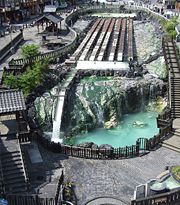

Erwin Bälz
Erwin Bälz was a German internist, anthropologist, personal physician to the Japanese Imperial Family and cofounder of modern medicine in Japan.- Biography :...
(German internist), Julius Scriba
Julius Scriba
Julius Karl Scriba was a German surgeon serving as a foreign advisor in Meiji period Japan, where he was an important contributor to the development of Western medicine in Japan.- Biography :...
(German surgeon), Bruno Taut
Bruno Taut
Bruno Julius Florian Taut , was a prolific German architect, urban planner and author active during the Weimar period....
(German architect), Ernest Satow (British researcher of Japan and diplomat), Kakuei Tanaka
Kakuei Tanaka
was a Japanese politician and the 64th and 65th Prime Minister of Japan from 7 July 1972 to 22 December 1972 and from 22 December 1972 to 9 December 1974 respectively...
(Japanese prime minister 1972 - 1974), Rikidōzan
Rikidozan
, better known as Rikidōzan , was a Korean Japanese professional wrestler, known as the "Father of Puroresu" and one of the most influential men in wrestling history. Initially, he had moved from his native country Korea to Japan to become a sumo wrestler...
(famous pro wrestler
Professional wrestling
Professional wrestling is a mode of spectacle, combining athletics and theatrical performance.Roland Barthes, "The World of Wrestling", Mythologies, 1957 It takes the form of events, held by touring companies, which mimic a title match combat sport...
). On the lower part of the Yubatake there is a small cascade and the rock has an emerald shade. This is one of the most popular spots for souvenir pictures.
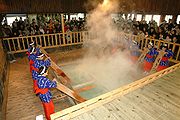
Netsu no yu
The , though located adjacent to the Yubatake, is a hot spring in its own right. The water is about 54 degrees Celsius, so it is not possible to bathe in it. For that reason there is the ancient tradition of , which means kneading or bashing the water. Using 1.80 meter long wooden boards the hot water is stirred, bashed, kneaded and thus cooled down. The simpler method of pouring in cold water is not practiced as it would dilute the healing power of the water. During the Yumomi ceremony, the Kusatsu song is sung and Japanese traditional dance is performed.The Bälz Museum
The Bälz Museum is another of Kusatsu's attractions. Located at the entrance to Kusatsu, visitors can inform themselves about the life and work of Erwin BälzErwin Bälz
Erwin Bälz was a German internist, anthropologist, personal physician to the Japanese Imperial Family and cofounder of modern medicine in Japan.- Biography :...
. There is also a souvenir shop with goods mostly from Germany and the Czech republic.
Onsen
There are more than 100 onsenOnsen
An is a term for hot springs in the Japanese language, though the term is often used to describe the bathing facilities and inns around the hot springs. As a volcanically active country, Japan has thousands of onsen scattered along its length and breadth...
in Kusatsu. The biggest and most popular are:


- The Bälz Onsen Center, situated on a plateau near Mount Tengu ski area, offers great scenery with lots of nature all around. It is a popular Après-skiAprès-skiAprès-ski refers to going out, having drinks, dancing, and generally socializing after skiing. It is popular in the Alps, where skiers often stop at bars on their last run of the day while still wearing all their ski gear. The concept is similar to the nineteenth hole in golf. This can also...
recreation spot.
Flowers

- Watasuge (Eriophorum Vaginatum, Hare's tail cotton grass)
- Zazensō (Simplocarpus foetidus, Skunk cabbage)
- Azumashakunage (Rhododendron Metternichii var. Japonica, a kind of Rhododendron)
- Hakusanshakunage (Rhododendron brachycarpum, a kind of Rhododendron)
- Rengetsutsuji (Rhododendron molle subsp. Japonicum, a kind of Azalea)
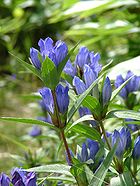
- Yanagiran (Epilobium angustifolium, Rosebay Willowherb)
- Nanakamado (Sorbus commixta, Japanese Rowan)
- Ezorindō (Gentiana triflora var. Japonica, blue Gentian)
- Komakusa (Dicentra peregrina, a kind of Magnolia)
Festivals and events

- One of the most important festivals is the summer Music Academy, which attracts famous musicians from all over Japan and even from abroad. The Japanese empress also visits the Music academy every year.
- The on 7-8 May is a much more traditional festival. The children of the KindergartenKindergartenA kindergarten is a preschool educational institution for children. The term was created by Friedrich Fröbel for the play and activity institute that he created in 1837 in Bad Blankenburg as a social experience for children for their transition from home to school...
near Kōsenji pull an elephant made of paper around the Yubatake in celebration of BuddhaGautama BuddhaSiddhārtha Gautama was a spiritual teacher from the Indian subcontinent, on whose teachings Buddhism was founded. In most Buddhist traditions, he is regarded as the Supreme Buddha Siddhārtha Gautama (Sanskrit: सिद्धार्थ गौतम; Pali: Siddhattha Gotama) was a spiritual teacher from the Indian...
's birthday. - The happens on the first of June. Ice is brought from a cave in Mt.Shirane, which was formed by an eruption of the volcano, and then is used to make tea. According to the legend, anyone who drinks this special tea will not get ill in the following year.


- During the first three days of August the takes place. This traditional festival has its origins in the , which in accordance with the Chinese calendarChinese calendarThe Chinese calendar is a lunisolar calendar, incorporating elements of a lunar calendar with those of a solar calendar. It is not exclusive to China, but followed by many other Asian cultures as well...
is celebrated during the hottest time of the year on the day of the ox. According to the lore, those that bathe in an Onsen in the hour of the ox (one to three AM) will not get ill for one year. In contrast, today's ceremony is totally different: The goddess of Onsen descends the stairs at Kōsenji symbolizing the descent from heaven. She then gathers water from seven big hot springs in Kusatsu and distributes the water to the baths in Kusatsu. On the third day she ascends the stairs to Kōsenji, representing the ascent to heaven. Through this ceremony the blessing of the gods is granted, which will make sure that the springs won't run dry.
- In last half of August, the Kusatsu International Summer Music Academy & Festival takes place. (since 1980)
- In addition, the following events take place in Kusatsu: Tour de Kusatsu (amateur bicycle race), , (hiking through a valley of snow walls several meters high), soccer and skiing events.
Thespa Kusatsu
Thespa Kusatsu
is a professional football club based in Gunma Prefecture in Japan. The club plays in J. League Division 2. J. League Division 2 is the second professional football league in Japan....
football
Football (soccer)
Association football, more commonly known as football or soccer, is a sport played between two teams of eleven players with a spherical ball...
club, although formed in and representing Kusatsu in the Japanese football league system
Japanese football league system
The Japanese association football league system is organized in a pyramidal shape similar to football league systems in many other countries around the world...
, actually plays in Maebashi.
Souvenirs
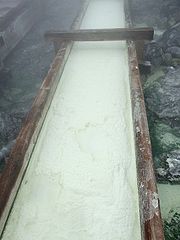

- Yu no hana ("hot water flower") is extracted from the hot water at the Yubatake and consists of mineral sedimentSedimentSediment is naturally occurring material that is broken down by processes of weathering and erosion, and is subsequently transported by the action of fluids such as wind, water, or ice, and/or by the force of gravity acting on the particle itself....
(mostly sulfurSulfurSulfur or sulphur is the chemical element with atomic number 16. In the periodic table it is represented by the symbol S. It is an abundant, multivalent non-metal. Under normal conditions, sulfur atoms form cyclic octatomic molecules with chemical formula S8. Elemental sulfur is a bright yellow...
), which, dried, is sold as powder by the town. Using Yu no hana, guests can experience onsen at home. is a kind of sweet made of a special sort of highland beans, which does not bear fruit below 700 meters above sea level. First the beans are dried, then put into water and finally they are cooked in sugar. The details of the making process are a company secret. - ManjūManjuManju is a Sanskrit word with following associated meanings - pleasant, sweet, snow, beautiful, Lord Shiva's name, clouds, morning dew and is predominantly an Indian male/female/given name.Manju, means a language of clouds.That is Rain...
is a well-known sweet in Japan, consisting of a pastry crust made of flour, rice flourRice flourRice flour is a form of flour made from finely milled rice. It is distinct from rice starch, which is usually produced by steeping rice in lye....
and buckwheatBuckwheatBuckwheat refers to a variety of plants in the dicot family Polygonaceae: the Eurasian genus Fagopyrum, the North American genus Eriogonum, and the Northern Hemisphere genus Fallopia. Either of the latter two may be referred to as "wild buckwheat"...
and a filling made of Azuki beanAzuki beanThe is an annual vine, Vigna angularis, widely grown throughout East Asia and the Himalayas for its small bean. The cultivars most familiar in north-east Asia have a uniform red color, but white, black, gray and variously mottled varieties are also known. Scientists presume Vigna angularis var...
paste. In onsen resorts, manjūManjuManju is a Sanskrit word with following associated meanings - pleasant, sweet, snow, beautiful, Lord Shiva's name, clouds, morning dew and is predominantly an Indian male/female/given name.Manju, means a language of clouds.That is Rain...
were often steamed using the steam rising from the hot springs.
Lakes and waterfalls

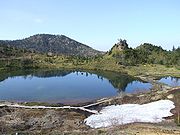
Crater lake
A crater lake is a lake that forms in a volcanic crater or caldera, such as a maar; less commonly and with lower association to the term a lake may form in an impact crater caused by a meteorite. Sometimes lakes which form inside calderas are called caldera lakes, but often this distinction is not...
s. The most famous ones are:
located 2,100 meters above sea level is the crater lake of Mount Shirane. It boasts a very high acidity and an emerald-green surface. The , 2,000 meters above sea level is located between Mount Shirane and Mount Motoshirane. Its water is crystal clear. The and the are waterfalls near Kusatsu.

